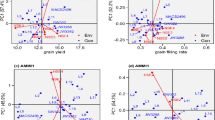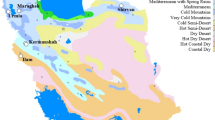Abstract
This study was performed for pattern analysis of genotype-by-environment (GE) interaction on 20 durum wheat genotypes grown in 15 testing environments during 2004–06 in Iran. Combined analysis of variance showed significant genotypes (G), environments (E), and GE interactions (P < 0.01), with environmental main effects being the predominant source of variation, followed by GE interaction. The results showed various patterns of genotype responses to different environment groups and assisted in structuring the durum wheat testing locations with identification of two major-environment groups with high genotype discrimination ability. The locations (Gachsaran and Ilam) corresponding to warm and semi-arid aresa were similar in genotype discrimination and showed no association with the other testing locations (Gonbad, Moghan, and Khoramabad) representing the Mediterranean area, indicating they differ in rankings of genotypes. The top-yielding genotypes, G13, G14 and G9, were highly adapted to warm and semi-arid environments, but those corresponding to the Mediterranean area had a high ability to discriminate the genotypes G16, G11, and Saimareh. The stability and adaptability of specific genotypes were assessed by plotting their nominal grain yields at specific environments in an ordination biplot, which aided in the identification of environment groups. Appropriate check genotypes for all environments or for specific environments were also identified. Pattern analysis allowed a sensible and useful summarization of GE interaction data set and helped to facilitate selecting superior genotypes for target-growing sites.
Similar content being viewed by others
References
Abdalla OS, Crossa J, Autrique E, DeLacy IH. 1996. Relationships among international testing sites of spring durum wheat. Crop Sci. 36: 33–40
Annicchiarico P. 2002. Defining adaptation strategies and yield stability targets in breeding programmes. In MS Kang, ed, Quantitative Genetics, Genomics and Plant Breeding, CABI, Wallingford, UK, pp 365–383
Basford KE, Kroonenberg PM, Cooper M. 1996. Threemode analytical methods for crop improvement programs. In M Cooper M, GL Hammer GL, eds, Plant Adaptation and Crop Improvement, CAB International, UK, pp 291–305
Basford KE, Kroonenberg PM, DeLacy IH. 1991. Three-way methods for multiattribute genotype x environment data: an illustrated partial survey. Field Crops Res. 27: 131–157
Ceccarelli S. 1996. Positive interpretation of genotype by environment interaction in relation to sustainability and biodiversity. In M Cooper, GL Hammer, eds, Plant Adaptation and Crop Improvement, CABI, Wallingford, UK, 467–486
Chapman SC, Crossa J, Basford KE, Kroonenberg PM. 1997. Genotype by environment interactions and selection for drought tolerance in tropical maize. II. Three-mode pattern analysis. Euphytica 95: 11–20
Cooper M, Brennan PS, Sheppard JA. 1996. A strategy for yield improvement of wheat which accommodates large genotype-by-environment interactions. In M Cooper, GL Hammer, eds, Plant Adaptation and Crop Improvement, CAB International, UK, pp 487–511
Cooper M, DeLacy IH. 1994. Relationships among analytical methods used to study genotypic variation and geno type-by-environment interaction in plant breeding multi-environment experiments. Theor. Appl. Genet. 88: 561–572
Cooper M, DeLacy IH, Eisemann RL. 1993. Recent advances in the study of genotype x environment interactions and their application to plant breeding. In BC Imrie, JB Hacker, eds, Proceedings of the 10th Australian Plant Breeding Conference, Canberra, Australian Convention and Travel Service: Canberra, Vol.1, pp 116–131
Cooper M, Woodruff DR, Eisemann RL, Brennan PS, DeLacy IH. 1995. A selection strategy to accommodate genotype by-environment interaction for grain yield of wheat: managed environments for selection among genotypes. Theor. Appl. Genet. 90: 492–502
DeLacy IH, Basford KE, Cooper M, Bull JK, McLaren CG. 1996. Analysis of multi-environment trials-an historical perspective. In M Cooper, GL Hammer, eds, Plant Adaptation and Crop Improvement, CAB International /IRRI/ICRISAT, Wallingford, pp 39–124
Fox PN, AA Rosielle. 1982. Reducing the influence of environmental main-effects on pattern analysis of plant breeding environments. Euphytica 31: 645–656
Gabriel KR. 1971. The bi-plot-graphical display of matrices with application to principal component analysis. Biometrika 58: 453–467
Gauch HG, Zobel RW. 1990. Imputing missing trial data. Theor. Appl. Genet. 79: 753–761
Gauch HG, Zobel RW. 1996. AMMI analysis of yield trials. In MS Kang, HG Gauch, eds, Genotype-by-Environment Interaction, CRC Press, Boca Raton, FL pp 85–122
Gauch HG, Zobel RW. 1997. Identifying mega-environments and targeting genotypes. Crop Sci. 37: 311–326
Haussmann BIG, Hess DE, Reddy BVS, Mukuru SZ, Kayentao M, Welzl HG, Geigerl HH. 2001. Pattern analysis of genotype x environment interaction for striga resistance and grain yield in African sorghum trials. Euphytica 122: 297–308
International Rice Research Institute (IRRI). 2005. IRRIS TAT software 5.0 for Windows. Manila, Philippines
Kempton RA. 1984. The use of bi-plots in interpreting variety by environment interactions. J. Agric. Sci. 103: 123–135
Kroonenberg PM. 1995. Introduction to biplots for GxE tables. Department of Mathematics, Research Report 51. Australia: Univ. of Queensland
Lillemo M, van Ginkel M, Trethowan RM, Hernandez E, Rajaram S. 2004. Associations among international CIM MYT bread wheat yield testing locations in high rainfall areas and their implications for wheat breeding. Crop Sci. 44: 1163–1169
Perkins JM, Jinks JL. 1960. Environmental and genotype environmental components of variability. III. Multiple lines & crosses. Heredity 23: 339–356
Pswarayi A, Van Eeuwijk FA, Ceccarelli S, Grando S, Comadran J, Russell JR, Franci E, Pecchioni N, Li Destri O, Akar T, Al-Yassin A et al.. 2008. Barley adaptation and improvement in the Mediterranean basin. Plant Breed. 127: 554–560
Redden RJ, DeLacy IH, Butler DG, Usher T. 2000. Analysis of line by environment interactions for yield in navy beans. 2. Pattern analysis of cultivars and environment within years. Aust. J. Agric. Res. 51: 607–617
Richards RA, Rebetzke GJ, Condon AG, van Herwaarden AF. 2002. Breeding opportunities for increasing the efficiency of water use and crop yield in temperate cereals. Crop Sci. 42: 111–121
Romagosa I, Fox PN. 1993. Genotype by environment inter action and adaptation. In MD Hayward, NO Bosemark, I Romagosa. eds, Plant Breeding: Principles and Prospects, Chapman & Hall, London, pp 373–390
Simmonds NW. 1979. Principles of Crop Improvement, Longman, London
Trethowan RM, Crossa J, van Ginkel M, Rajaram S. 2001. Relationships among bread wheat international yield testing locations in dry areas. Crop Sci. 41: 1461–1469
Trethowan RM, van Ginkel M, Rajaram S. 2002. Progress in breeding wheat for yield and adaptation in global drought affected environments. Crop Sci. 42: 1441–1446
Trethowan RM, van Ginkel M, Ammar K, Crossa J, Payne TS, Cukadar B, Rajaram S, Hernandez E. 2003. Associations among twenty years of international bread wheat yield evaluation environments. Crop Sci. 43: 1698–1711
Ward JH. 1963. Hierarchical grouping to optimize an objective function. J. Am. Stat. Assoc. 58: 236–244
Williams WT. 1976. Pattern analysis in agricultural science. Elsevier Scientific Publishing Company, Amsterdam
Yan W, Rajcan I. 2002 Biplot evaluation of test sites and trait relations of soybean in Ontario. Crop Sci. 42:11–20
Zhang Y, He Z, Zhang A, van Ginkel M, Ye G. 2006. Pattern analysis on grain yield performance of Chinese and CIMMYT spring wheat cultivars sown in China and CIMMYT. Euphytica 147: 409–420
Zobel RW, Wright MG and Gauch HG. 1988. Statistical analysis of yield trial. Agron. J. 80: 388–393
Author information
Authors and Affiliations
Corresponding author
Rights and permissions
About this article
Cite this article
Mohammadi, R., Mohammadi, M., Karimizadeh, R. et al. Analysis of genotype-by-environment interaction for grain yield of rainfed durum wheat genotypes in warm winter areas of Iran. J. Crop Sci. Biotechnol. 13, 267–274 (2010). https://doi.org/10.1007/s12892-010-0028-5
Received:
Revised:
Accepted:
Published:
Issue Date:
DOI: https://doi.org/10.1007/s12892-010-0028-5




